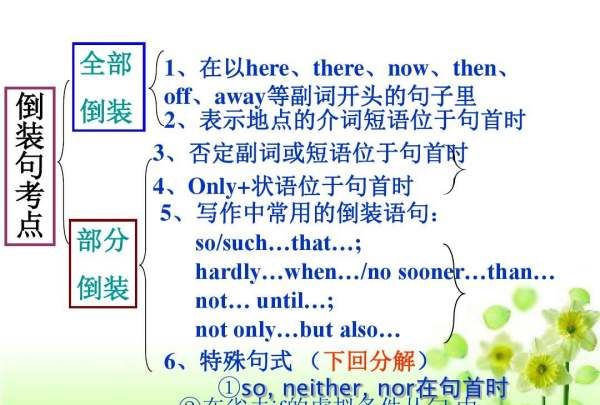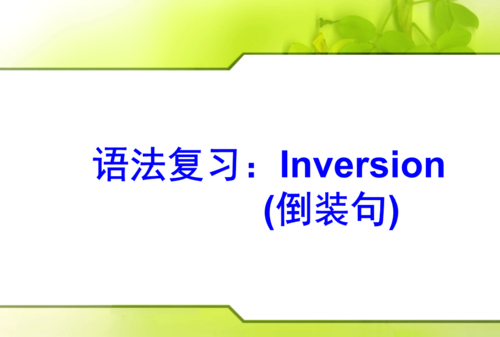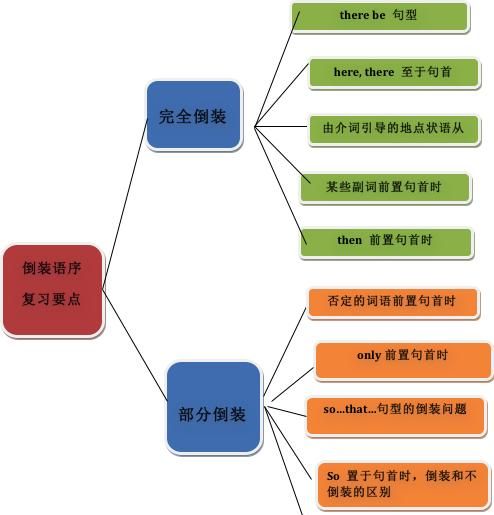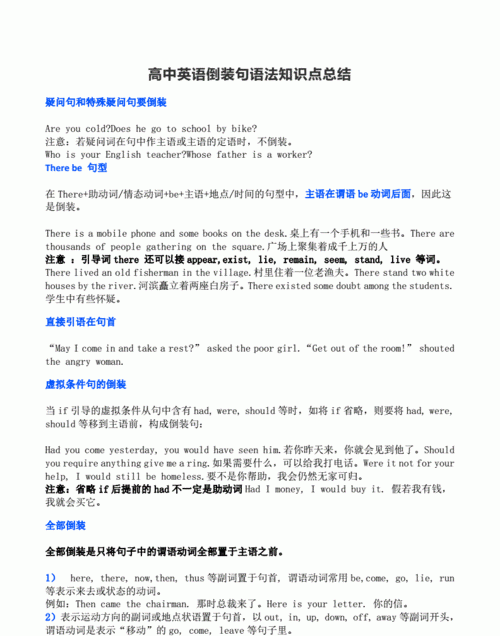本文目录
半倒装句的基本结构
基本结构:一般放在主语之后,但有时为了强调和突出谓语的意义,在一些疑问句或感叹句中,就把谓语提前到主语前面。
倒装分为完全倒装和半倒装。
1,完全倒装是把主谓完全颠倒,如:On the ground lies a man .原型是A man lies on the gound .
主语a man 谓语lies.
2,部分倒装,就是把情态动词、助动词等置于句首,如 do .
常见的倒装:not until ,nor , so , 以及副词状语开头的句子都用倒装。
虚拟语气中的倒装句如果虚拟语气的条件从句谓语动词中含有were, had, could, should,有时可将if省去,而将条件从句的主语置于were, had, should, could 之后。
为了强调、突出等词语的目的而颠倒原有语序的句式叫做倒装句。在倒装句中,颠倒了的成分可以恢复原位而句意基本不变,句法成分不变。

扩展资料:
在倒装句中,颠倒了的成分可以恢复原位而句意基本不变,句法成分不变。英语句子的倒装一是由于语法结构的需要而进行的倒装,二是由于修辞的需要而进行的倒装。
主语和谓语是句子的核心,它们之间有两种语序。
一是主语在谓语之前称为自然语序(Natural Order);
二是主语在谓语之后则称为倒装语序(Inverted Order)。
而倒装语序中又有完全倒装(Full Inversion)和部分倒装(Partial Inversion)。
前一种情况,倒装是必须的,否则就会出现语法错误;后一种情况,倒装是选择性的,倒装与否只会产生表达效果上的差异。
1.表示强调
倒装句最突出、最常见的修辞效果就是强调,其表现形式如下:
1.only +状语或状语从句置于句首,被该状语修饰的句子用部分倒装。
例子:
Only in this way can you solve this problem.
只有用这种方法,你才可以解决这个问题。
Only after he had spoken out the word did he realize he had made a big mistake.
只有当他已经说出那个字后才意识到自己犯了个大错误。
2. hardly,in no way,little,scarcely,seldom,never,no more,no longer,not,not only,no sooner,not only … (but also),not until… 等具有否定意义的词或词组位于句首,句子用部分倒装。
例子:
No sooner had I got home than it began to rain.
我刚到家就下起了雨。
Seldom do I go to work by bus.
我很少乘公共汽车上班。
Not until twelve o'clock did she go to bed last night .
她昨晚十二点才上床睡觉。
3. so / such...that结构中的so或such位于句首可以构成部分倒装句,表示强调so /such和that之间的部分。
例子:
So unreasonable was his price that everybody startled.
他的要价太离谱,令每个人都瞠目结舌。
To such length did she go in rehearsal that the two actors walked out.
她的彩排进行得那么长,以致于那两个演员都走出去了。
以上各例都用倒装语序突出了句首成分,其语气较自然语序强烈,因而具有极佳的修辞效果。
参考资料:百度百科——倒装句
完全倒装句构成
14.1 倒装句之全部倒装
全部倒装是只将句子中的谓语动词全部置于主语之前。此结构通常只用与一般现在时和 一般过去时。常见的结构有:
1) here, there, now, then, thus等副词置于句首, 谓语动词常用be, come, go, lie, run。
There goes the bell.
Then came the chairman.
Here is your letter.
2) 表示运动方向的副词或地点状语置于句首,谓语表示运动的动词。
Out rushed a missile from under the bomber.
Ahead sat an old woman.
注意:上述全部倒装的句型结构的主语必须是名词,如果主语是人称代词则不能完全倒装。
Here he comes. Away they went.
14.2 倒装句之部分倒装
部分倒装是指将谓语的一部分如助动词或情态倒装至主语之前。如果句中的谓语没有助动词或情态动词,则需添加助动词do, does或did,并将其置于主语之前。
1) 句首为否定或半否定的词语,如no, not, never, seldom, little, hardly, at no time, in no way, not until… 等。
Never have I seen such a performance.
Nowhere will you find the answer to this question.
Not until the child fell asleep did the mother leave the room.
当Not until引出主从复合句,主句倒装,从句不倒装。
注意: 如否定词不在句首不倒装。
I have never seen such a performance.
The mother didn't leave the room until the child fell asleep.
典型例题
1) Why can't I smoke here?
At no time___ in the meeting-room
A. is smoking permitted B. smoking is permitted
C. smoking is it permitted D. does smoking permit
答案A. 这是一个倒装问题。当否定词语置于句首以表示强调时,其句中的主谓须用倒装结构。 这些否定词包括no, little, hardly, seldom, never, not only, not until等。本题的正常语序是 Smoking is permitted in the meeting-room at no time.
2) Not until the early years of the 19th century ___ what heat is.
A. man did know B. man know C. didn't man know D. did man know
答案D. 看到Not until…的句型,我们知道为一倒装句,答案在C,D 中选一个。
改写为正常语序为,Man did not know what heat is until the early years of the 19th. 现在将not提前,后面就不能再用否定了,否则意思就变了。
14.3 以否定词开头作部分倒装
如 Not only…but also, Hardly/Scarcely…when, No sooner… than
Not only did he refuse the gift, he also severely criticized the sender.
Hardly had she gone out when a student came to visit her.
No sooner had she gone out than a student came to visit her.
典型例题
No sooner___ than it began to rain heavily.
A. the game began B. has the game begun
C. did the game begin D. had the game begun
答案D. 以具有否定意义的副词放在句首时,一般采用倒装句(谓语前置)。这类表示否定意义的词有never, seldom, scarcely, little, few, not, hardly, 以及not only…but (also), no sooner…than, hardly… when scarcely… when 等等。
注意:只有当Not only… but also连接两个分句时,才在第一个分句用倒装结构。如果置于句首的Not only… but also仅连接两个并列词语,不可用倒装结构。
Not only you but also I am fond of music.
14.4 so, neither, nor作部分倒装
表示"也"、"也不" 的句子要部分倒装。
Tom can speak French. So can Jack.
If you won't go, neither will I.
典型例题
---Do you know Jim quarrelled with his brother?
---I don't know, _____.
A. nor don't I care B. nor do I care C. I don't care neither D. I don't care also
答案:B. nor为增补意思"也不关心",因此句子应倒装。A错在用 don't 再次否定, C neither 用法不对且缺乏连词。 D缺乏连词。
注意: 当so引出的句子用以对上文内容加以证实或肯定时,不可用倒装结构。意为"的确如此"。
Tom asked me to go to play football and so I did.
---It's raining hard. ---So it is.
14.5 only在句首要倒装的情况
Only in this way, can you learn English well.
Only after being asked three times did he come to the meeting.
如果句子为主从复合句,则主句倒装,从句不倒装
Only when he is seriously ill, does he ever stay in bed.
14.6 as, though 引导的倒装句
as / though引导的让步从句必须将表语或状语提前 (形容词, 副词, 分词, 实义动词提前)。
注意:
1) 句首名词不能带任何冠词。
2) 句首是实义动词, 其他助动词放在主语后。如果实义动词有宾语和状语, 随实义动词一起放在主语之前。
Try hard as he will, he never seems able to do the work satisfactorily.
注意:
让步状语从句中,有though,although时,后面的主句不能有but,但是 though 和yet可连用。
14.7 其他部分倒装
1) so… that 句型中的so 位于句首时,需倒装。
So frightened was he that he did not dare to move an inch.
2) 在某些表示祝愿的句型中:
May you all be happy.
3) 在虚拟语气条件句中从句谓语动词有were, had, should等词,可将if 省略,把 were, had, should 移到主语之前,采取部分倒装。
Were I you, I would try it again.
典型例题:
1) Not until the early years of the 19th century___ what heat is
A. man did know B. man knew C. didn't man know D. did man know
答案为D. 否定词Not在句首,要求用部分倒装的句子结构。
2) Not until I began to work ___ how much time I had wasted.
A. didn't I realize B. did I realize C. I didn't realize D. I realize
答案为B。
3) Do you know Tom bought a new car?
I don't know, ___.
A. nor don't I care B. nor do I care
C. I don't care neither D. I don't care also
解析:答案为B. 句中的nor引出部分倒装结构,表示"也不"。由 so, neither, nor引导的倒装句,表示前一情况的重复出现。其中, so用于肯定句, 而 neither, nor 用在否定句中。

什么是英语倒装句
14.1 倒装句之全部倒装
全部倒装是只将句子中的谓语动词全部置于主语之前。此结构通常只用与一般现在时和 一般过去时。常见的结构有:
1) here, there, now, then, thus等副词置于句首, 谓语动词常用be, come, go, lie, run。
There goes the bell.
Then came the chairman.
Here is your letter.
2) 表示运动方向的副词或地点状语置于句首,谓语表示运动的动词。
Out rushed a missile from under the bomber.
Ahead sat an old woman.
注意:上述全部倒装的句型结构的主语必须是名词,如果主语是人称代词则不能完全倒装。
Here he comes. Away they went.
14.2 倒装句之部分倒装
部分倒装是指将谓语的一部分如助动词或情态倒装至主语之前。如果句中的谓语没有助动词或情态动词,则需添加助动词do, does或did,并将其置于主语之前。
1) 句首为否定或半否定的词语,如no, not, never, seldom, little, hardly, at no time, in no way, not until… 等。
Never have I seen such a performance.
Nowhere will you find the answer to this question.
Not until the child fell asleep did the mother leave the room.
当Not until引出主从复合句,主句倒装,从句不倒装。
注意: 如否定词不在句首不倒装。
I have never seen such a performance.
The mother didn't leave the room until the child fell asleep.
典型例题
1) Why can't I smoke here?
At no time___ in the meeting-room
A. is smoking permitted B. smoking is permitted
C. smoking is it permitted D. does smoking permit
答案A. 这是一个倒装问题。当否定词语置于句首以表示强调时,其句中的主谓须用倒装结构。 这些否定词包括no, little, hardly, seldom, never, not only, not until等。本题的正常语序是 Smoking is permitted in the meeting-room at no time.
2) Not until the early years of the 19th century ___ what heat is.
A. man did know B. man know C. didn't man know D. did man know
答案D. 看到Not until…的句型,我们知道为一倒装句,答案在C,D 中选一个。
改写为正常语序为,Man did not know what heat is until the early years of the 19th. 现在将not提前,后面就不能再用否定了,否则意思就变了。
14.3 以否定词开头作部分倒装
如 Not only…but also, Hardly/Scarcely…when, No sooner… than
Not only did he refuse the gift, he also severely criticized the sender.
Hardly had she gone out when a student came to visit her.
No sooner had she gone out than a student came to visit her.
典型例题
No sooner___ than it began to rain heavily.
A. the game began B. has the game begun
C. did the game begin D. had the game begun
答案D. 以具有否定意义的副词放在句首时,一般采用倒装句(谓语前置)。这类表示否定意义的词有never, seldom, scarcely, little, few, not, hardly, 以及not only…but (also), no sooner…than, hardly… when scarcely… when 等等。
注意:只有当Not only… but also连接两个分句时,才在第一个分句用倒装结构。如果置于句首的Not only… but also仅连接两个并列词语,不可用倒装结构。
Not only you but also I am fond of music.
14.4 so, neither, nor作部分倒装
表示"也"、"也不" 的句子要部分倒装。
Tom can speak French. So can Jack.
If you won't go, neither will I.
典型例题
---Do you know Jim quarrelled with his brother?
---I don't know, _____.
A. nor don't I care B. nor do I care C. I don't care neither D. I don't care also
答案:B. nor为增补意思"也不关心",因此句子应倒装。A错在用 don't 再次否定, C neither 用法不对且缺乏连词。 D缺乏连词。
注意: 当so引出的句子用以对上文内容加以证实或肯定时,不可用倒装结构。意为"的确如此"。
Tom asked me to go to play football and so I did.
---It's raining hard. ---So it is.
14.5 only在句首要倒装的情况
Only in this way, can you learn English well.
Only after being asked three times did he come to the meeting.
如果句子为主从复合句,则主句倒装,从句不倒装
Only when he is seriously ill, does he ever stay in bed.
14.6 as, though 引导的倒装句
as / though引导的让步从句必须将表语或状语提前 (形容词, 副词, 分词, 实义动词提前)。
注意:
1) 句首名词不能带任何冠词。
2) 句首是实义动词, 其他助动词放在主语后。如果实义动词有宾语和状语, 随实义动词一起放在主语之前。
Try hard as he will, he never seems able to do the work satisfactorily.
注意:
让步状语从句中,有though,although时,后面的主句不能有but,但是 though 和yet可连用。
14.7 其他部分倒装
1) so… that 句型中的so 位于句首时,需倒装。
So frightened was he that he did not dare to move an inch.
2) 在某些表示祝愿的句型中:
May you all be happy.
3) 在虚拟语气条件句中从句谓语动词有were, had, should等词,可将if 省略,把 were, had, should 移到主语之前,采取部分倒装。
Were I you, I would try it again.
典型例题:
1) Not until the early years of the 19th century___ what heat is
A. man did know B. man knew C. didn't man know D. did man know
答案为D. 否定词Not在句首,要求用部分倒装的句子结构。
2) Not until I began to work ___ how much time I had wasted.
A. didn't I realize B. did I realize C. I didn't realize D. I realize
答案为B。
3) Do you know Tom bought a new car?
I don't know, ___.
A. nor don't I care B. nor do I care
C. I don't care neither D. I don't care also
解析:答案为B. 句中的nor引出部分倒装结构,表示"也不"。由 so, neither, nor引导的倒装句,表示前一情况的重复出现。其中, so用于肯定句, 而 neither, nor 用在否定句中。

英语语法倒装句
倒装
英语句子的语序通常是主语在前,谓语在后,这种语序称作正常语序或自然语序。但有时出于语法或达到某种修辞目的(强调、承上启下、平衡等)的需要,要把谓语动词放在主语前面,这种语序称作倒装(Inversion)语序。将谓语动词完全移至主语之前,称完全倒装(Full Inversion);如果只是把助动词或情态动词放在主语之前,称为部分倒装。
1. there be结构的倒装
在“there be”(或there + appear to be,come,exist, happen to be, lie, live, occur, remain, seem, seem to be, stand, used to be) 雪结构中,倒装形式为完全倒装。如:
There were many students in the reading room in this evening.
今晚阅览室里有许多学生。
2. here,there,now,then等引起的倒装
在以here,there,now,then等简短副词引起的句子中(前三个须用一般现在时),动词往往是be,come,go等时, 这类句子大多带有引起注意的含义。如:
Here comes the bus.
公共汽车来了。
但要注意:如果主语是人称代词,则不用倒装。如:
Here they are. 他们在这儿。
3. 省略if的非真实条件状语从句中的倒装
虚拟结构中的条件从句省去if时,were, had, should须移至主语之前。
如:
Had you worked harder at college, you would have got better job.
如果你在大学期间读书用功些,现在就会找到一份更好的工作。
4. 副词so, neither, nor等引起的倒装
在用so, nor, neither表示“也/不……”这一类结构里其公式是:
肯定: so+be/have/助动词/情态动词+主语
否定: Neither(nor)+be/have/助动词/情态动词+主语。如:
—He has been to Beijing.他去过北京。
—So have I.我也去过。
—They can’t answer the question.他们不会回答这个问题。
—Neither than I.我也不会。
5. what,how引起的倒装
以What, how开头的感叹句(表语或宾语提前)。如:
What beautiful weather (it is)!
多好的天气啊!(表语提前)
What a lovely picture he painted!
他画了一张多好的画啊!(宾语提前)
6. 疑问词或连接词引起的倒装
在疑问词或连接词whether等引起的从句中。如:
Whatever you may say, I won’t go there.
无论你怎样说,我都不会去那儿。(状语从句中宾语提前)
7. 否定词位于句首时引起的倒装
(1). never,seldom,hardly,little,few等引起的倒装
否定词never,seldom,rarely,hardly,barely,scarcely,little,few等位于句首时所引起的倒装句通常为部分倒装形式,如果谓语动词为be的一般现在时或一般过去时,则为完全倒装形式。如:
Never shall I forget the days when you were with us.
我很少有时间去看电影。
(2). nowhere,no longer,no more等引起的倒装
nowhere(无处),no longer(不再),no more(也不)等否定词位于句首时所引起的倒装句通常为部分倒装形式,如果谓语动词为be的一般现在时或一般过去时,则为完全倒装形式:
No longer was he in charge of this work.
他不再负责这项工作了。
(3). not until,not a,not in the least等引起的倒装
not until(直到……才),not a(一个……也没有),not in the least(一点儿也不),not for a minute/moment(一点儿也不)等位于句首时,通常引起倒装(not a之后的名词作主语时除外),其形式通常为部分倒装形式,如果谓语动词为be的一般现在时或一般过去时,则为完全倒装形式。如:
Not until all the demands had been turned down did the workers decide to go on strike.
一直到所有的要求遭到拒绝之后,工人们才决定罢工。
(4). under no circumstances,by no means,in no way等引起的倒装
in/under no circumstances(无论如何不),by no means (决不),in no case (无论如何不),in no way (决不),on no account (决不可),on no condition(决不)等短语位于句首时所引起的倒装句通常为部分倒装形式,如果谓语动词为be的一般现在时或一般过去时,则为完全倒装形式。如:
In no case must force be resorted to.
决不准许诉诸武力。
8. 关联连词位于句首时引起的倒装
(1). not only...but also引起的倒装
not only...but also位于句首所引起的倒装句为部分倒装形式,如果谓语动词为be的一般现在时形式或一般过去时形式,则为完全倒装形式。如: Not only should we not be afraid of difficulties, but also we should try our best to overcome them.
我们不仅应该不怕困难,而且应该尽最大努力去克服它们。
(2). neither...nor引起的倒装
neither...nor位于句首引起的倒装句为部分倒装形式,如果谓语动词为be的一般现在时或一般过去时,则为完全倒装形式。如:
Neither Peter wanted the responsibility,nor did his wife.
彼得不想担此责任,他妻子也不想担此责任。
(3). hardly...when/no sooner...than引起的倒装
hardly/scarcely/barely...when或no
sooner...than位于句首所引起的倒装句为部分倒装形式,如果谓语动词为be的一般现在时或一般过去时,则为完全倒装形式。如:
Hardly had he arrived when/No sooner had he arrived than he was asked to leave again.
他刚到就又被请走了。
(4). so...that引起的倒装
so...that位于句首所引起的倒装句为部分倒装形式,如果谓语动词为be的一般现在时或一般过去时,则为完全倒装形式。如:
So angry was he (He so angry) that he couldn’t speak.
他如此愤怒,以致说不出话来。
(5). such...that引起的倒装
such...that位于句首所引起的倒装句为部分倒装形式,如果谓语动词为be的一般现在时或一般过去时,则为完全倒装形式。如:
Such was the force of the explosion that all the windows were broken.
爆炸的威力如此之大,以致所有的窗户都被震破了。
9. only引起的倒装
当副词only位于句首并修饰状语或宾语时,引起句子的倒装,其形式通常为部分倒装,如果谓语动词为be的一般现在时或一般过去时,则为完全倒装。如:
Only in this way can you solve this problem.
只有用这种方法,你才可以解决这个问题。
10. 表语位于句首时所引起的倒装
当作表语的形容词、副词、介词短语等位于句首时,常常引起倒装,其形式为完全倒装:
Aristotle says,“Plato is dear to me,but dearer still is truth.”
亚里斯多德说,“吾爱柏拉图,但更爱真理。”
11. 状语位于句首时所引起的倒装
(1). 当位于句首的状语是一些表示地点的介词短语或表示运动方向的副词(如away,back,down,in,off,out,up)时,常常引起倒装,其形式为全部倒装。如:
Away went the runners.
赛跑手们刷地跑开了。
(2).介词短语作地点状语,放在句首,后面跟的是不及物动词be,come,sit live,stand,lie,exist等时常常引起倒装,其形式为全部倒装。如:
Next to the table is a chair.
桌旁有把椅子。
12. 状语从句中的倒装
(1).让步状语从句中的倒装
as引导的让步状语从句中的倒装:
在as引导的让步状语从句中,位于句首的可以是形容词、名词、副词,还可以是谓语动词的一部分,从而形成从句的部分倒装。如:
Tires as he was, he continued the work.
虽然他累了,但是仍然继续工作。
(2).方式状语从句中的倒装
as引导的方式状语从句一般为正常语序,但是,如果主语比谓语长,可将谓语动词置于主语之前,形成完全倒装。如:
He believed,as did all his family,that the king was the supreme lord.
他和他全家人一样,都认为国王是至高无上的君主。
(3).比较状语从句的倒装
than引导的比较状语从句中的倒装:
由than引导的比较状语从句一般为正常语序。但是,如果主语较长,可将谓语动词置于主语之前,形成完全倒装:
Western Nebraska generally receives less snow than does eastern Nebraska.
内布拉斯加西部地区的降雪通常比东部地区少。
13. the more...,the more...结构中的倒装
在以the more..., the more...引导的倒装结构中,采用部分倒装;如果主句的主语较长,可将谓语动词置于主语之前,形成完全倒装。如:
The more books you read(宾语提前),the wider your knowledge is(表语提前).
书读得越多,知识就越渊博。

以上就是关于what倒装句英语结构 ,半倒装句的基本结构的全部内容,以及what倒装句英语结构 的相关内容,希望能够帮到您。

